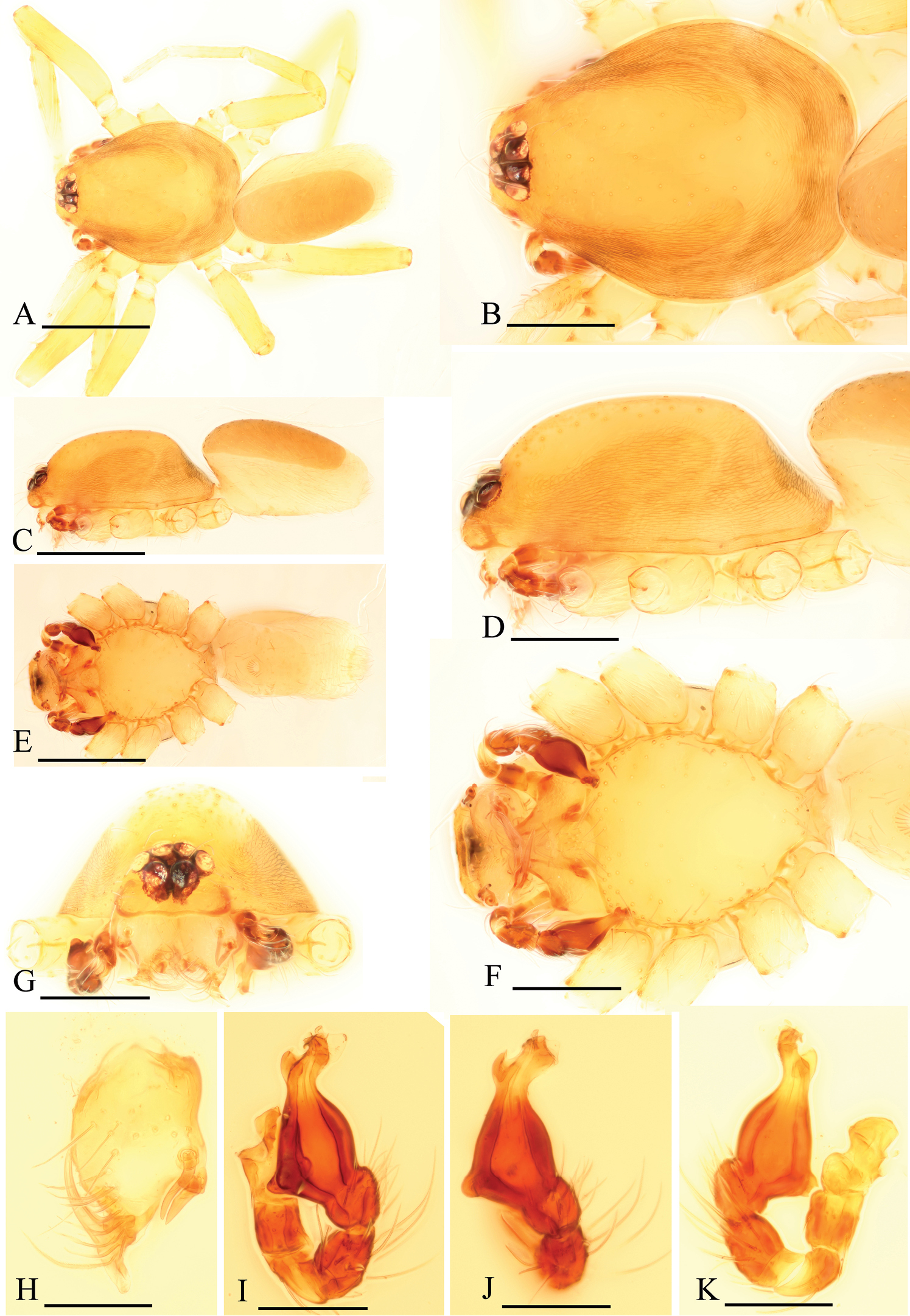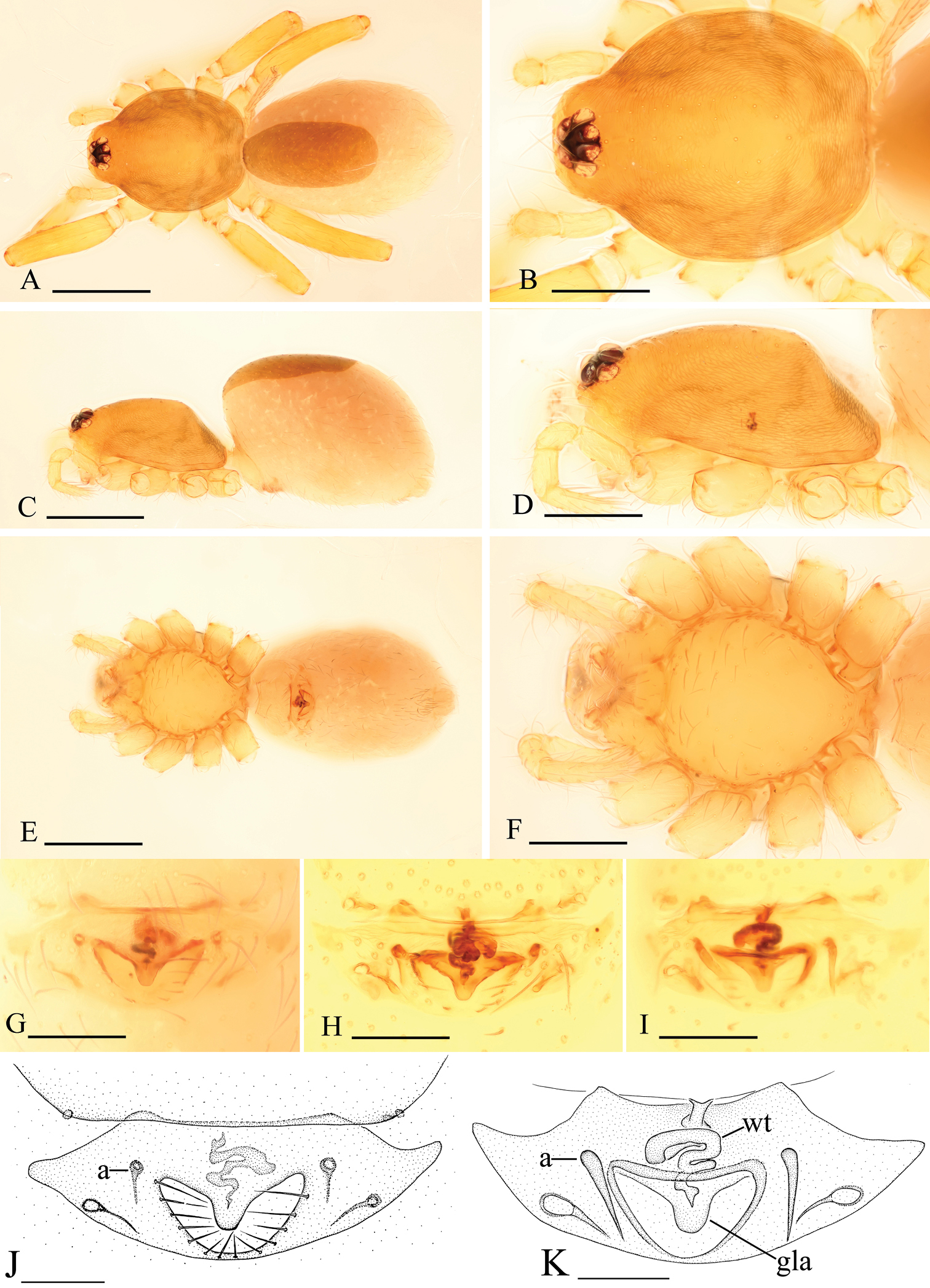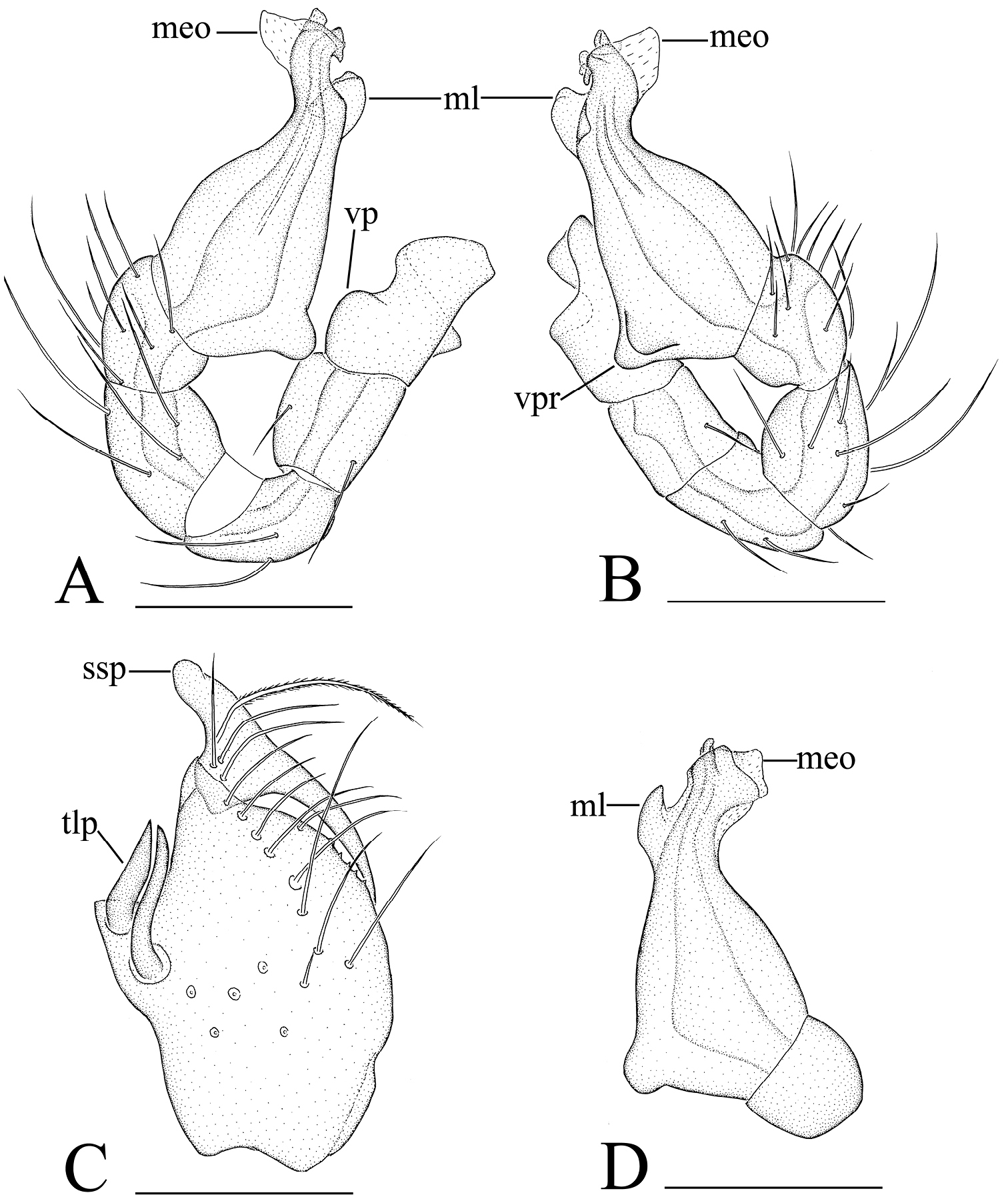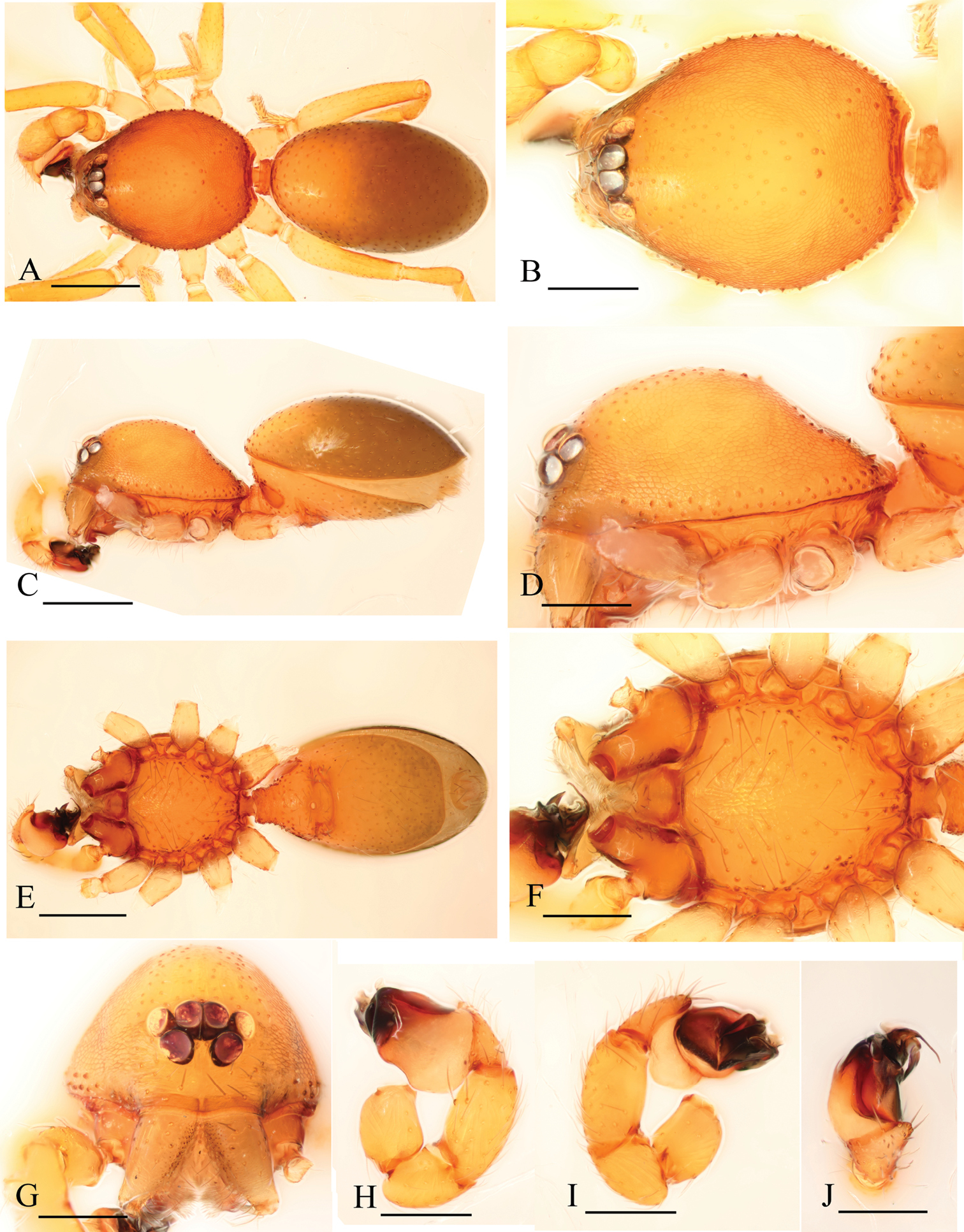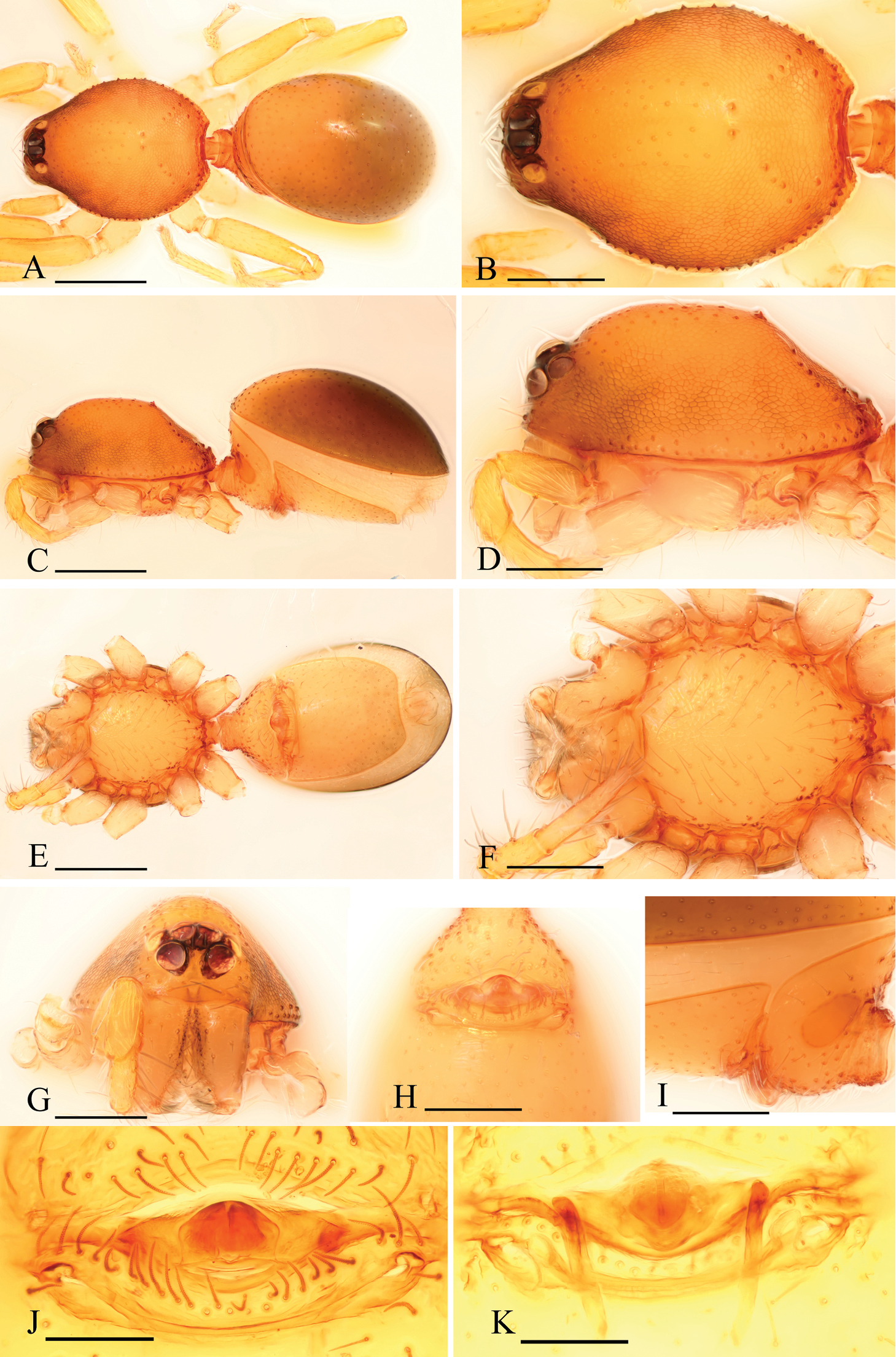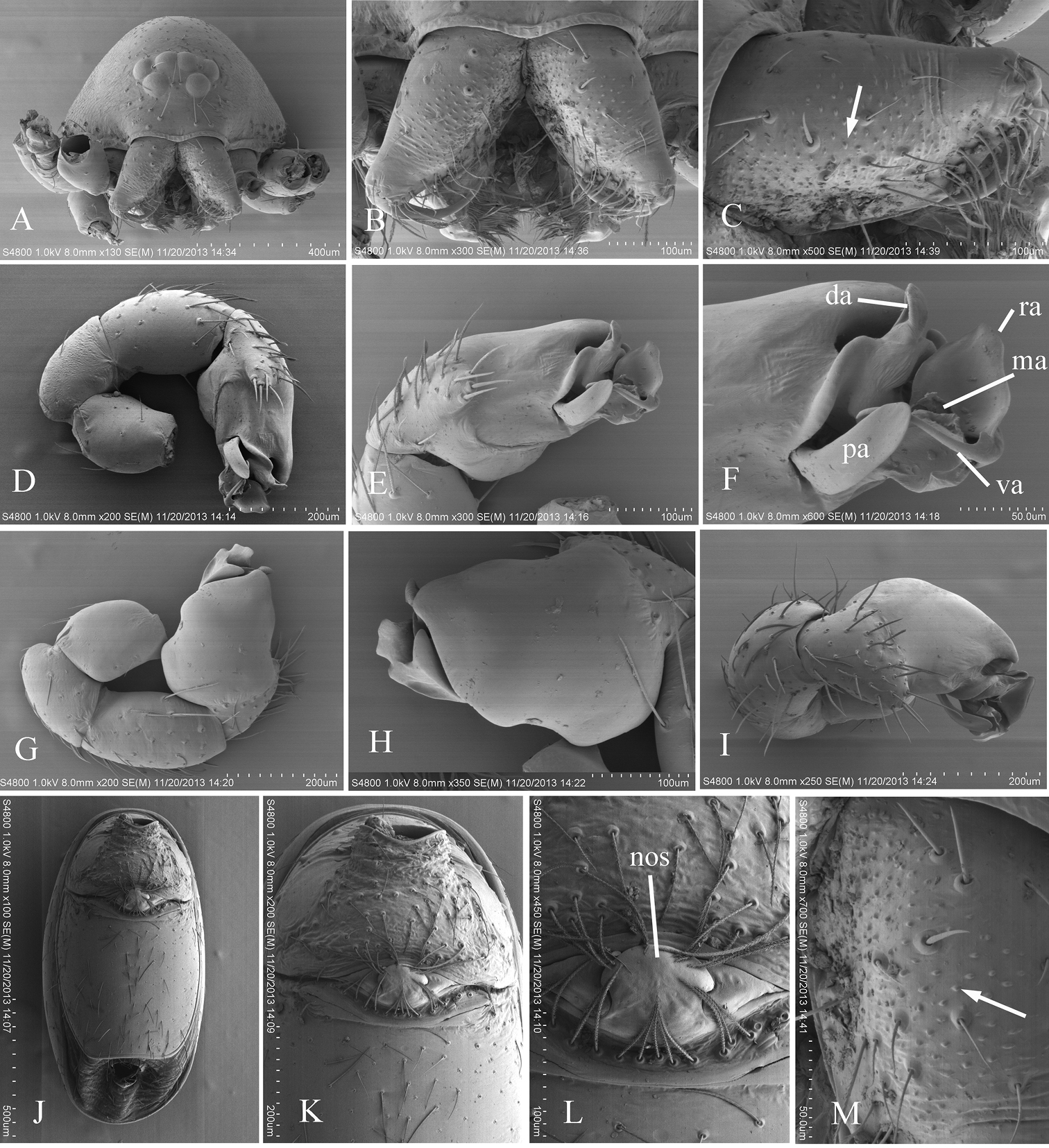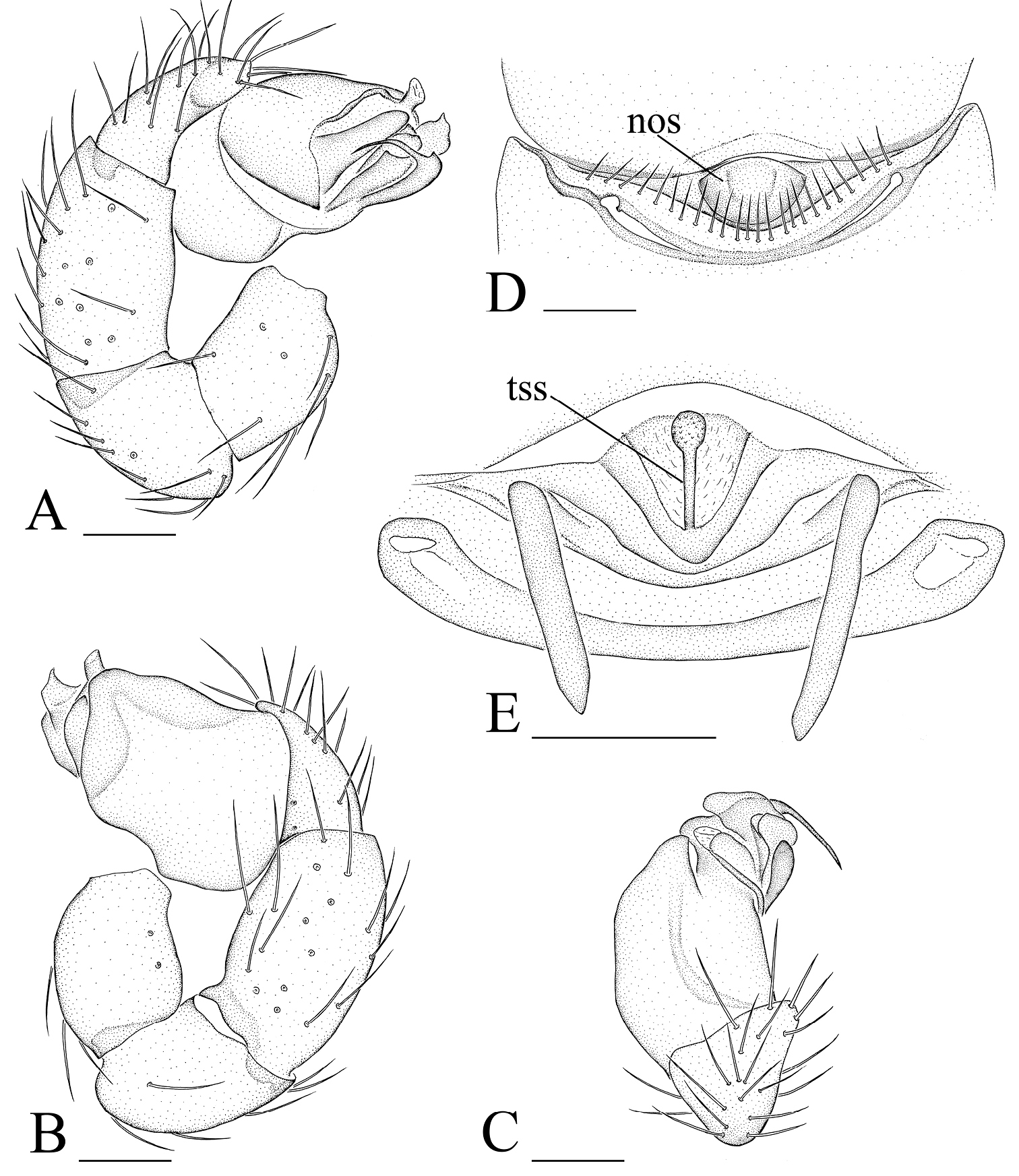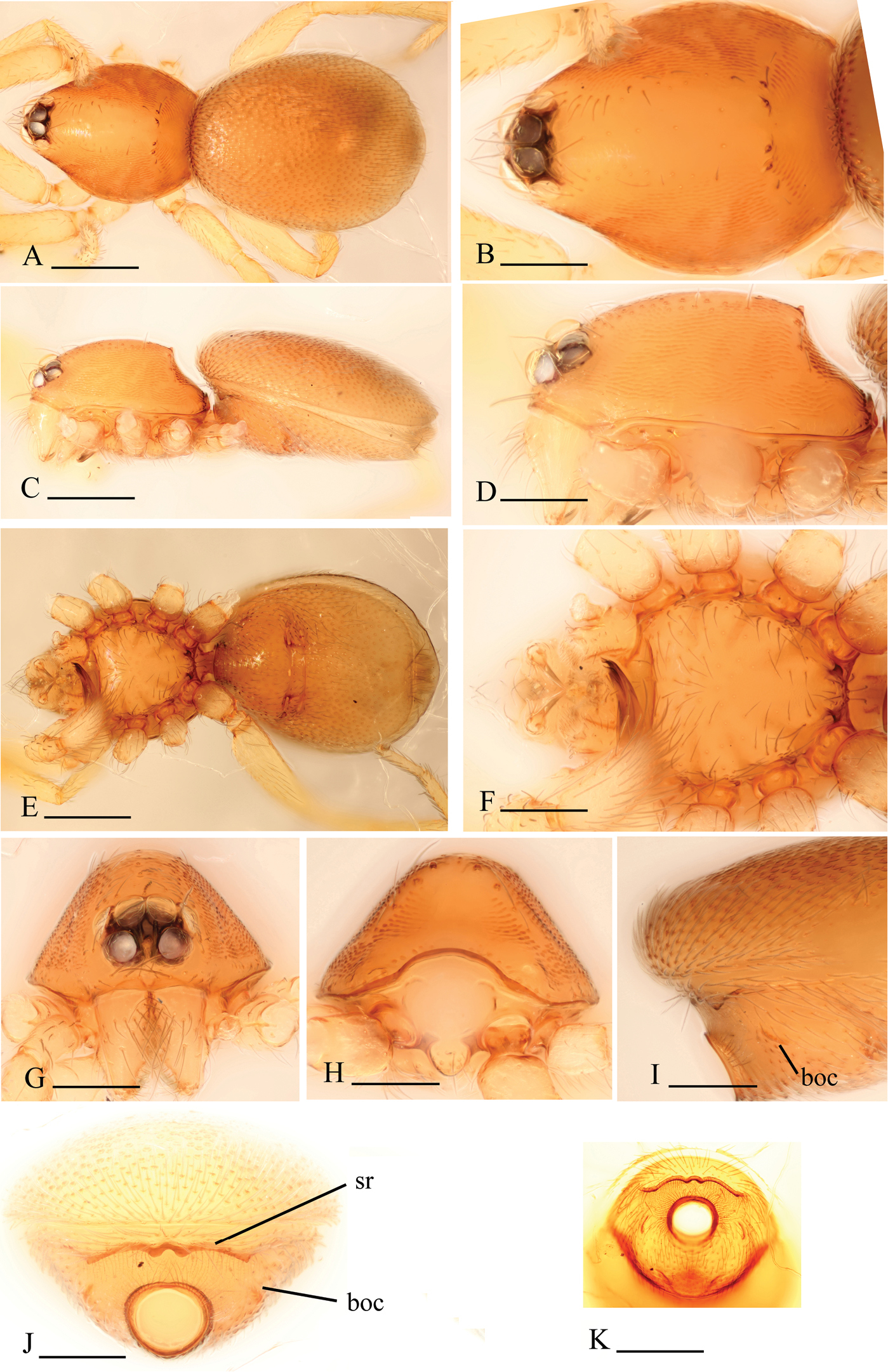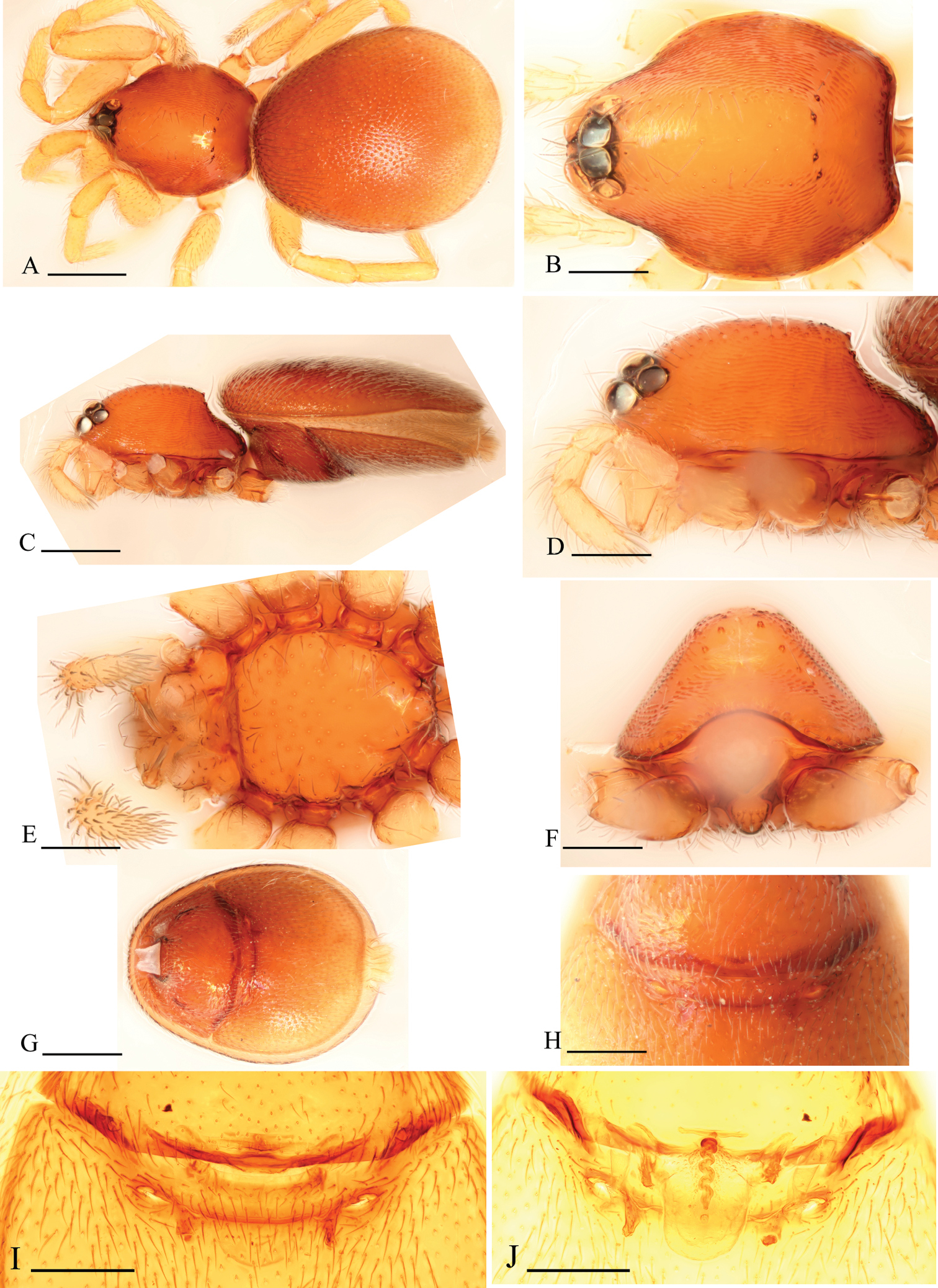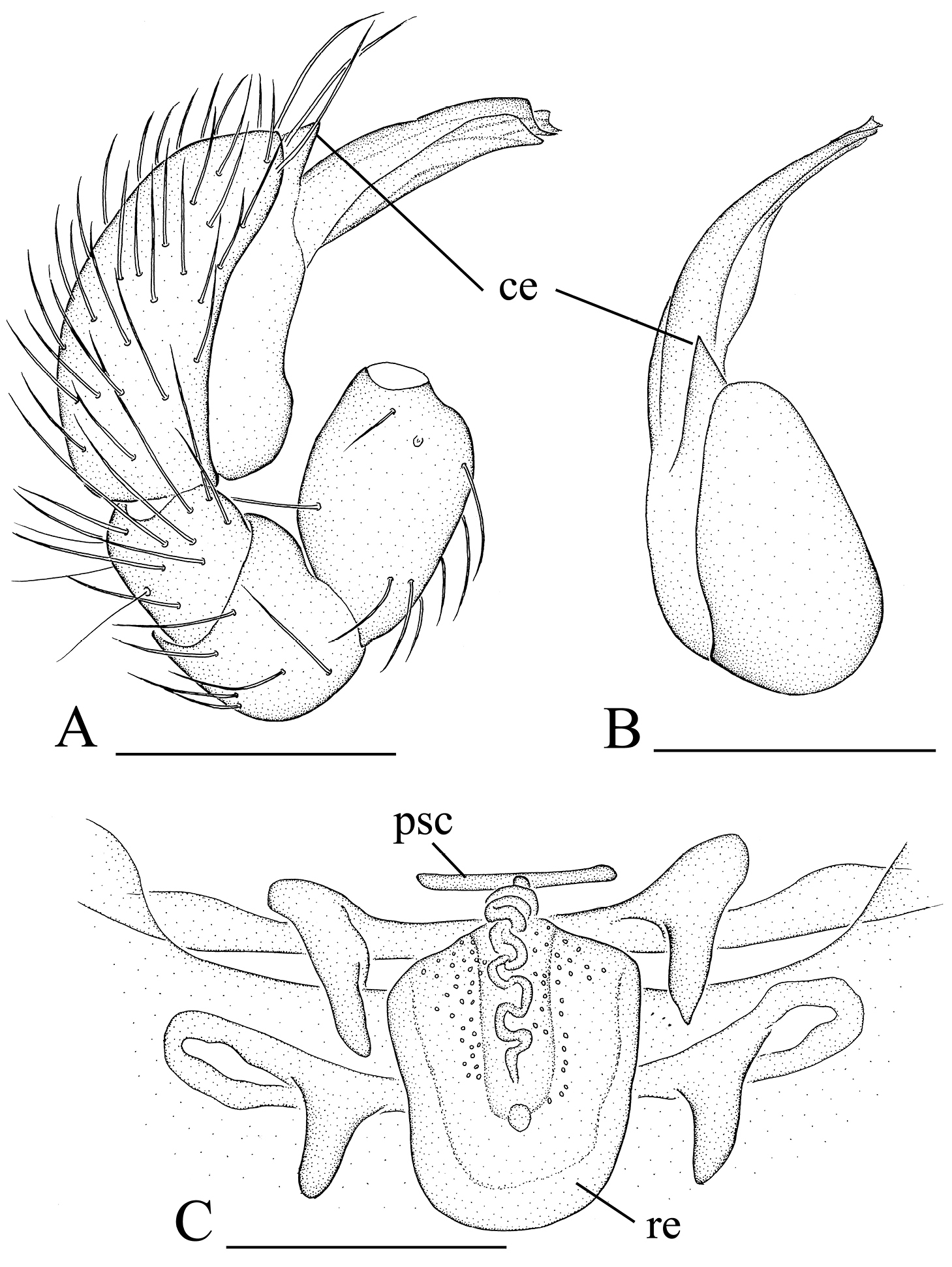






Citation: Tong Y, Li S (2014) A survey of oonopid spiders in Taiwan with descriptions of three new species. ZooKeys 396: 67–86. doi: 10.3897/zookeys.396.7033
The oonopid spiders of Taiwan are surveyed. Seven genera and 13 species are recognized, including 3 new species: Ischnothyreus kentingensis sp. n., Xyphinus hwangi sp. n. and Xestaspis shoushanensis sp. n. Seven species are newly recorded from this region: Brignolia parumpunctata (Simon, 1893), Opopaea apicalis s (Simon, 1893), Opopaea cornuta Yin & Wang, 1984, Opopaea deserticola Simon, 1891, Orchestina sinensis Xu, 1987, Pseudotriaeris karschi (Bösenberg & Strand, 1906) and Xestaspis loricata (L. Koch, 1873).
Taxonomy, haplogyne, diagnosis, litter, island
Goblin spiders are small (1–4 mm), haplogyne, litter or canopy-dwelling, free hunting spiders. They are distributed nearly worldwide and are abundant in the tropics. Currently, the family includes 1325 described species in 97 genera (
The island of Taiwan is situated some 180 km off the southeastern coast of mainland China, and has an area of 35, 883 km2. The oonopid spider fauna of this region has been poorly studied. To date, only four species, Gamasomorpha cataphracta Karsch, 1881, Ischnothyreus narutomii (Nakatsudi, 1942), Ischnothyreus peltifer (Simon, 1891) and Opopaea sauteri Brignoli, 1974, have been recorded from Taiwan (
The specimens were examined using a Leica M205C stereomicroscope. Details were studied with the use of an Olympus BX51 compound microscope. All illustrations were made using a drawing tube and inked on ink jet plotter paper. Photos were made with a Canon EOS 550D zoom digital camera (18 megapixels). Vulvae were cleared in lactic acid. Scanning electron microscope images (SEM) were taken with a Hitachi S-4800. Measurements were taken using an Olympus BX51 compound microscope and are in millimeters.
The following abbreviations are used in the text: ALE = anterior lateral eyes; PLE = posterior lateral eyes; PME = posterior median eyes.
All specimens are deposited in the Institute of Zoology, Chinese Academy of Sciences in Beijing (IZCAS) and Shenyang Normal University in Shenyang (SYNU).
http://species-id.net/wiki/Brignolia_parumpunctata
CHINA: Taiwan: Pingtung County, Kenting, seaside near the Howard Beach Resort, 21°56'27.00"N, 120°48'26.68"E, elevation ca. 34 m, 25–28 June 2013, S. Li & Y. Tong leg., 1 ♂, 1 ♀ (SYNU-13); 1 ♂, 1 ♀ (SYNU-31).
This species has been well described by many authors (i.e.,
Pantropical. Newly recorded from Taiwan.
http://species-id.net/wiki/Gamasomorpha_cataphracta
Not examined.
China, Japan, Korea, Philippines.
http://zoobank.org/4E4779BF-82D5-470A-AE0C-4D5383D5CB1B
http://species-id.net/wiki/Ischnothyreus_kentingensis
Figs 1–3Holotype ♂ (IZCAS AR 27808): CHINA: Taiwan: Pingtung County, Kenting, hills near the Howard Beach Resort, 21°56'27.00"N, 120°48'26.68"E, elevation ca. 34 m, 27 June 2013, S. Li & Y. Tong leg. Paratypes: same data as holotype, 1 ♂, 2 ♀ (SYNU-20); same data as holotype, 1 ♂, 5 ♀ (SYNU-58); same data as holotype, 1 ♂, 1 ♀ (SYNU-21).
The specific name is taken from the type locality; adjective.
The new species is similar to Ischnothyreus spineus Tong & Li, 2012, but can be distinguished by the male chelicerae which each bear two strong, short thorn-like processes (tlp in Figs 1H, 3C) and the female genital area possessing a large goblet-like atrium (Fig. 2G–K). The males of Ischnothyreus spineus bear only one long, curved thorn-like process on each of the chelicerae (see
Male (holotype). Total length 1.26; carapace 0.69 length, 0.54 width; abdomen 0.61 length, 0.33 width. Habitus as in Fig. 1A, C, E. Carapace: orange-brown, with brown egg-shaped patches behind eyes, oval in dorsal view, pars cephalica strongly elevated in lateral view, surface and sides strongly reticulate (Fig. 1B, D). Eyes: six, in one group, well developed, ALE largest, PME and PLE nearly equal sized; posterior eye row straight from above, procurved from front (Fig. 1G). Mouthparts: chelicerae slightly divergent, with a slightly sclerotized process at base of fangs (ssp) and two strong, thorn-like processes (tlp) in the middle of the retrolateral margin; fang groove with a few small denticles (Figs 1H, 3C). Anterior margin of labium not indented at middle. Anteromedian tip of endites with one strong, tooth-like projection (Fig. 1F). Abdomen: posterior spiracles not connected by groove. Pedicel tube short, unmodified, scutum extending far dorsal of pedicel. Dorsal scutum covering about 4/5 of abdomen, about equal to the abdomen width, not fused to epigastric scutum. Epigastric and postepigastric scutum well sclerotized, pale orange, fused. Leg spine formula: femur I with 2 prolateral and 1 small retrolateral spine, tibia I with 4 pairs, metatarsus I with 2 pairs of long ventral spines. Spination of leg II similar to leg I except femur with only one prolateral spine. Legs III and IV spineless. Genitalia: sperm pore situated at level of anterior spiracles. Palp strongly sclerotized, trochanter with ventral projection (vp); patella about as long as femur, not enlarged; cymbium brown, not fused with bulb, bulb brown, more than twice as long as cymbium, stout, tapering apically, with two small ventral protuberances (vpr), at the bending site with a membranous lobe (ml), distal part of bulb with membranous outgrowth (meo) (Figs 1I–K, 3A, B, D).
Ischnothyreus kentingensis sp. n., male. A, C, E habitus, dorsal, lateral and ventral views B, D, F, G prosoma, dorsal, lateral, ventral and anterior views H left chelicera, frontal view I–K left palp, retrolateral, dorsal and prolateral views. Scale bars: A, C, E = 0.4 mm; B, D, F, G = 0.2 mm; H–K = 0.1 mm.
Female (paratype). Total length 1.51; carapace 0.64 length, 0.52 width; abdomen 0.87 length, 0.56 width. Habitus as in Fig. 2A, C, E. As in male except as noted. Carapace: without any pattern, pars cephalica slightly elevated in lateral view (Fig. 2B, D). Mouthparts: chelicerae and endites unmodified (Fig. 2F). Abdomen: dorsal scutum covering about 2/3 of abdomen, about 1/2 of abdomen width. Postepigastric scutum elongated hexagonal, not fused to epigastric scutum, with short posteriorly directed lateral apodemes (a) (Fig. 2G, H, J). Genitalia: at the middle of the anterior edge of the postepigastric scutum runs a dark, strongly winding tube posteriorly (wt), ending in a large goblet-like atrium (gla) close to posterior edge of scutum (Fig. 2I, K).
Ischnothyreus kentingensis sp. n., female. A, C, E habitus, dorsal, lateral and ventral views B, D, F prosoma, dorsal, lateral and ventral views G, J genital area, ventral view H genital area, ventral view (cleared in lactic acid) I, K genital area, dorsal view (cleared in lactic acid). Scale bars: A, C, E = 0.4 mm; B, D, F = 0.2 mm; G–K = 0.1 mm. Abbreviations: a = apodeme; gla = goblet-like atrium; wt = winding tube.
Ischnothyreus kentingensis sp. n., male. A, B left palp, prolateral and retrolateral views C left chelicera, frontal view D left palpal bulb, dorsal view. Scale bars: 0.1 mm. Abbreviations: meo = membranous outgrowth; ml = membranous lobe; ssp = slightly sclerotized process; tlp = thorn-like processes; vp = ventral projection; vpr = ventral protuberance.
Known only from the type locality.
http://species-id.net/wiki/Ischnothyreus_narutomii
CHINA: Taiwan: Nantou County, Ren’ai Town, Songgang Village, 24°05'13.30"N, 121°10'20.07"E, elevation ca. 2067 m, 2 July 2013, S. Li, G. Zheng & Y. Tong leg., 1 ♂, 1 ♀ (SYNU-23); 4 ♂, 5 ♀ (SYNU-24); 5 ♂, 10 ♀ (SYNU-49).
China, Japan.
http://species-id.net/wiki/Ischnothyreus_peltifer
CHINA: Taiwan: Pingtung County, Kenting, seaside near Howard Beach Resort, 21°56'27.00"N, 120°48'26.68"E, elevation ca. 34 m, 25–28 June 2013, S. Li & Y. Tong leg., 1 ♀ (SYNU-22); 3 ♀ (SYNU-52).
Pantropical, Canada and Europe (introduced).
http://species-id.net/wiki/Opopaea_apicalis
CHINA: Taiwan: Pingtung County, Kenting, seaside near Howard Beach Resort, 21°56'27.00"N, 120°48'26.68"E, elevation ca. 34 m, 25–28 June 2013, S. Li & Y. Tong leg., 3 ♂, 3 ♀ (SYNU-12); 8 ♂, 14 ♀ (SYNU-33).
This species has been well described by
Pantropical. Newly recorded from Taiwan.
http://species-id.net/wiki/Opopaea_cornuta
CHINA: Taiwan: Nantou County, Huisun Forest Area, 24°05'16.74"N, 121°02'04.69"E, elevation ca. 788 m, 30 June to 1 July 2013, S. Li, G. Zheng & Y. Tong leg., 1 ♀ (SYNU-44).
China, Laos. Newly recorded from Taiwan.
http://species-id.net/wiki/Opopaea_deserticola
CHINA: Taiwan: Kaohsiung City, Shoushan Mountain, 29 June 2013, S. Li, G. Zheng & Y. Tong leg., 4 ♂, 4 ♀ (SYNU-14); Pingtung County, Kenting, hills near Howard Beach Resort, 27 June 2013, S. Li & Y. Tong leg., 1 ♂, 1 ♀ (SYNU-15); Nantou County, Huisun Forest Area, 24°05'16.74"N, 121°02'04.69"E, elevation ca. 788 m, 30 June to 1 July 2013, S. Li, G. Zheng & Y. Tong leg., 6 ♂, 6 ♀ (SYNU-16); 15 ♂, 21 ♀ (SYNU-28); 18 ♂, 22 ♀ (SYNU-48); Pingtung County, Kenting, Sheding Nature Park, 21°57'25.15"N, 120°49'06.29"E, elevation ca. 221 m, 26 June 2013, S. Li & Y. Tong leg., 1 ♂, 2 ♀ (SYNU-50).
This species has been well described by
Pantropical. Newly recorded from Taiwan.
http://species-id.net/wiki/Opopaea_sauteri
CHINA: Taiwan: Pingtung County, Kenting, seaside near Howard Beach Resort, 21°56'27.00"N, 120°48'26.68"E, elevation ca. 34 m, 25–28 June 2013, S. Li & Y. Tong leg., 1 ♂, 1 ♀ (SYNU-17); 2 ♀ (SYNU-32).
China.
http://species-id.net/wiki/Orchestina_sinensis
CHINA: Taiwan: Pingtung County, Kenting, hills near Howard Beach Resort, 27 June 2013, S. Li & Y. Tong leg., 1 ♀ (SYNU-40); Nantou County, Huisun Forest Area, 24°05'16.74"N, 121°02'04.69"E, elevation ca. 788 m, 30 June to 1 July 2013, S. Li, G. Zheng & Y. Tong leg., 2 ♀ (SYNU-45); Kaohsiung City, Shoushan Mountain, 29 June 2013, S. Li, G. Zheng & Y. Tong leg., 1 ♂ (SYNU-53).
This species has been recorded from the Anhui and Zhejiang Provinces of China. It seems to be widely distributed in southern China.
Southern China. Newly recorded from Taiwan.
http://species-id.net/wiki/Pseudotriaeris_karschi
CHINA: Taiwan: Pingtung County, Kenting, seaside near Howard Beach Resort, 21°56'27.00"N, 120°48'26.68"E, elevation ca. 34 m, 25–28 June 2013, S. Li & Y. Tong leg., 2 ♂, 2 ♀ (SYNU-19); 4 ♂, 2 ♀ (SYNU-41).
Brignoli erected the genus Pseudotriaeris in 1974, based on the type species Pseudotriaeris karschi from Japan.
China, Japan. Newly recorded from Taiwan.
http://zoobank.org/DCCD5A23-F3B9-44F5-A361-1D8499B77D09
http://species-id.net/wiki/Xyphinus_hwangi
Figs 4–7Holotype ♂ (IZCAS AR 27809): CHINA: Taiwan: Kaohsiung City, Shoushan Mountain, 29 June 2013, S. Li, G. Zheng & Y. Tong leg. Paratypes: same data as holotype, 3 ♂, 5 ♀ (SYNU-18); same data as holotype, 12 ♂, 23 ♀ (SYNU-36); same data as holotype, 2 ♂, 1 ♀ (SYNU-47).
The specific name is a patronym honoring Dr. Chung-Chi Hwang (National University of Kaohsiung), who is a leading taxonomist of terrestrial snails in Taiwan.
The new species is similar to Pseudotriaeris karschi (see
Male (holotype). Total length 1.87; carapace 0.81 length, 0.63 width; abdomen 0.99 length, 0.61 width. Habitus as in Fig. 4A, C, E. Carapace: orange, dorsal scutum yellow-brown, chelicerae, sternum, legs and ventral scutum light yellow. Carapace dorsally smooth, covered with rows of short hairs; sides finely reticulate; carapace margin with two rows of small denticles on either side and some larger denticles on the posterior slope (Fig. 4B, D). No fovea. Posterior pits lacking. Eyes six, ALE largest, PLE smallest; posterior eye row slightly recurved from above, straight from front. Clypeus with sinuous anterior margin; clypeus height about 1.5 times the diameter of anterior eyes (Figs 4G, 6A). Mouthparts: chelicerae toothless, with many small granules on the promargin (Fig. 6B, C, M). Endites with backwards folded ridge. Sternum smooth (Fig. 4F). Legs spineless. Abdomen: shape of abdomen normal, not overlapping the carapace. Dorsal scutum ovoid, smooth, nearly entirely covering the abdomen. Booklung covers ovoid, large. Pedicel tube ribbed. Scuto-pedicel region unmodified. Posterior spiracles connected by groove. Postepigastric scutum strongly sclerotized; spinneret scutum present as an incomplete ring. Genitalia: sperm pore oval, medium sized, situated at level of anterior spiracles. Palp (Figs 4H–J, 6D–I, 7A–C): femur inserted near the middle of patella; patella about as long as femur; cymbium strongly protruding prolaterally; bulb with complicated apophyses, ventral apophysis very slender and strongly curved (va in Fig. 6F).
Xyphinus hwangi sp. n., male. A, C, E habitus, dorsal, lateral and ventral views B, D, F, G prosoma, dorsal, lateral, ventral and anterior views H–J left palp, retrolateral, prolateral and dorsal views. Scale bars: A, C, E = 0.4 mm; B, D, F–J= 0.2 mm.
Female (paratype). Total length 1.84; carapace 0.81 length, 0.62 width; abdomen 0.95 length, 0.92 width. Habitus as in Fig. 5A, C, E. As in male except as noted. Endites unmodified (Fig. 5F). Postepigastric scutum rectangular, not fused to epigastric scutum, with long posteriorly directed lateral apodemes. Genitalia: with a large nose-shaped protuberance (nos in Figs 6L, 7D) at the middle of the anterior edge of the postepigastric scutum; in dorsal view, a thin stick-shape sclerite extending anteriorly (tss in Figs 5K, 7E).
Xyphinus hwangi sp. n., female. A, C, E habitus, dorsal, lateral and ventral views B, D, F, G prosoma, dorsal, lateral, ventral and anterior views H, I abdomen, ventral and lateral views J, K genital area, ventral and dorsal views (cleared in lactic acid). Scale bars: A, C, E = 0.4 mm; B, D, F–I = 0.2 mm; J, K = 0.1 mm.
Xyphinus hwangi sp. n., SEM. A male prosoma, anterior view B, C, M male chelicerae, frontal view (arrow shows the small granules) D, G, I male left palp, prolateral, retrolateral and dorsal views E, H male left palpal bulb, prolateral and retrolateral views F distal part of male left palpal bulb, prolateral view J female abdomen, ventral view K, L female genital area, ventral view. Abbreviations: da = dorsal apophysis; ma = medial apophysis; nos = nose-shaped protuberance; pa = prolateral apophysis; ra = retrolateral apophysis; va = ventral apophysis.
Xyphinus hwangi sp. n. A–C male left palp, prolateral, retrolateral and dorsal views D, E female genital area, ventral and dorsal views. Scale bar: 0.1 mm. Abbreviations: nos = nose-shaped protuberance; tss = thin stick-shape sclerite.
Known only from the type locality.
http://species-id.net/wiki/Xestaspis_loricata
CHINA: Taiwan: Pingtung County, Kenting, seaside near Howard Beach Resort, 21°56'27.00"N, 120°48'26.68"E, elevation ca. 34 m, 25–28 June 2013, S. Li & Y. Tong leg., 2 ♀ (SYNU-30); Nantou County, Huisun Forest Area, 24°05'16.74"N, 121°02'04.69"E, elevation ca. 788 m, 30 June to 1 July 2013, S. Li, G. Zheng & Y. Tong leg., 2 ♀ (SYNU-43).
Well described in above mentioned papers.
Australia, China, Laos, Micronesia. Newly recorded from Taiwan.
http://zoobank.org/D9171ACC-20CA-437F-8836-A9D5CCA61EA3
http://species-id.net/wiki/Xestaspis_shoushanensis
Figs 8–10Holotype ♂ (IZCAS AR 27810): CHINA: Taiwan: Kaohsiung City, Shoushan Mountain, 29 June 2013, S. Li, G. Zheng & Y. Tong leg. Paratypes: same data as holotype, 1 ♀ (SYNU-11); same data as holotype, 2 ♀ (SYNU-57).
The specific name is taken from the type locality; adjective.
The new species is similar to Xestaspis paulina (see
Xestaspis shoushanensis sp. n., male. A, C, E habitus, dorsal, lateral and ventral views B, D, F, G, H prosoma, dorsal, lateral, ventral, anterior and posterior views I booklung covers, lateral view J, K abdomen, anterior and anteroventral views. Scale bars: A, C, E, K = 0.4 mm; B, D, F–J = 0.2 mm. Abbreviations: boc = booklung covers; sr = scutal ridge.
Xestaspis shoushanensis sp. n., female. A, C habitus, dorsal and lateral views B, D, E, F prosoma, dorsal, lateral, ventral and posterior views G abdomen, ventral view H genital area, ventral view I, J genital area, ventral and dorsal views (cleared in lactic acid). Scale bars: A, C, G = 0.4 mm; B, D–F, H–J = 0.2 mm.
Xestaspis shoushanensis sp. n. A male left palp, prolateral view B male left palpal bulb, dorsal view C genital area, dorsal view. Scale bar: 0.1 mm. Abbreviations: ce = conical extension; psc = paddle-like sclerite; re = receptaculum.
Male (holotype). Total length 1.87; carapace 0.82 length, 0.65 width; abdomen 1.09 length, 0.84 width. Habitus as in Fig. 8A, C, E. Body yellow or reddish brown, chelicerae and sternum lighter, legs yellow. Carapace: pars cephalica slightly elevated in lateral view. Carapace dorsally smooth, with two rows of short, finely hairs laterally; sides strongly striated; lateral margin with a row of finely hairs. All eyes oval, about subequal; clypeus height about equal to the diameter of anterior eyes (Fig. 8B, D, G). Sternum with narrow, transverse palpal groove, covered with thin hairs standing in small pits, radial furrows present (Fig. 8F). Abdomen: dorsal scutum ovoid, punctate, densely covered with short hairs. Booklung covers very small, anterolateral edge with tubercle. Pedicel tube short, without dorsolateral extension, scuto-pedicellar region with straight scutal ridge (Fig. 8J, K). Colulus very small, bearing two setae. Genitalia: sperm pore narrow, slit-like. Palp (Fig. 10A, B): cymbium and bulbus yellow. Bulbus distally tapering, ending as pointed conical extension (ce). Cymbium not extending beyond distal tip of bulb. Embolus-conductor complex, mesially bent in dorsal view.
Female (paratype). Total length 2.11; carapace 0.86 length, 0.69 width; abdomen 1.28 length, 1.05 width. Habitus as in Fig. 9A, C. As in male except as noted. Genitalia: ventral view: simple, externally without special features (Fig. 9H, I). Dorsal view: vulva with a small receptaculum and complicated sclerites (Figs 9J, 10C).
Known only from the type locality.
The manuscript benefited greatly from comments by Yuri M. Marusik (Russia) and two anonymous reviewers. David J. Court (Singapore) kindly checked the English. Dr Guo Zheng (SYNU) helped in the field work. This study was supported by the National Natural Science Foundation of China (NSFC-31071886/31172121/31372157), the Program for Liaoning Excellent Talents in University (LJQ2013114) for Yanfeng Tong and China National Funds for Distinguished Young Scientists (NSFC-31025023) for Shuqiang Li.
